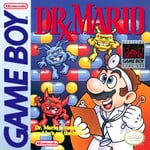Dr. Mario (game): Difference between revisions
| Line 21: | Line 21: | ||
==Game Modes== | ==Game Modes== | ||
===1-Player Game=== | ===1-Player Game=== | ||
When a 1-Player game is started, the | When a 1-Player game is started, the player can choose one of 20 levels. The number of viruses is equal to the number of the level x4. (For instance, if the player chose Level 5, the number of viruses would be 20.) The speed of the pills as they fall can also be selected: low, medium or high. As the game level progresses, though, the speed will gradually increase. If Level 20 is beaten, the playing field will still contain the same amount of viruses, although the level number will continue to increase. | ||
===2-Player Game=== | ===2-Player Game=== | ||
Revision as of 15:55, September 30, 2007
Dr. Mario is an arcade-style puzzle video game created by Nintendo, and was released for the Nintendo Entertainment System (NES) and Game Boy in 1990. It was ported into the Nintendo PlayChoice-10 arcade machines in North America. In 2004, Nintendo re-released the original Dr. Mario for the Game Boy Advance, as part of the Classic NES Series. In 2005, Nintendo again released Dr. Mario for Game Boy Advance, but this time as an enhanced remake in Dr. Mario & Puzzle League. Dr. Mario's gameplay is very similar to that of Tetris. Like Tetris, the player had to line pills up to destroy viruses.
Gameplay
All Dr. Mario games feature a large grid as the main game interface. This grid (in the shape of a large pill bottle) starts out partially filled with viruses of three color: red, yellow, and blue. The main objective of the Dr. Mario game is to clear the grid of the viruses. This objective can be fulfilled with the help of tri-colored pills called Megavitamins. These pills are two-blocks wide and come in the same color as the viruses. Usually, they are sectrioned off into two random colors, but occasionally contain only one random color. These pills are guided down the grid by the Player's D-Pad. They can be rotated by the "A" Button. To eliminate a virus, four blocks of a color (pill or virus) must be piled up. The stack will then dissapear. If a virus was contained in the stack, the virus will be eliminatred as well. If the stacks of pills or viruses reach the top of the grid, the player receives a Game Over.
Game Modes
1-Player Game
When a 1-Player game is started, the player can choose one of 20 levels. The number of viruses is equal to the number of the level x4. (For instance, if the player chose Level 5, the number of viruses would be 20.) The speed of the pills as they fall can also be selected: low, medium or high. As the game level progresses, though, the speed will gradually increase. If Level 20 is beaten, the playing field will still contain the same amount of viruses, although the level number will continue to increase.
2-Player Game
A 2-Player Vs. game mode is also availible for selection. In this mode, two players battle to either clear their grid first, or cause their opponent to get a Game Over. The Level and Speed options are chosen independently by each player before the game begins.
During a two-player battle, whenever a row or column is cleared with one Megavitamin, a corresponding number (two, three, or the maximum, four) of randomised pill halves drops on to the opponent's grid. The player who is given the pill halves must wait for the random colors to drop onto their screen before they can drop a Megavitamin.
